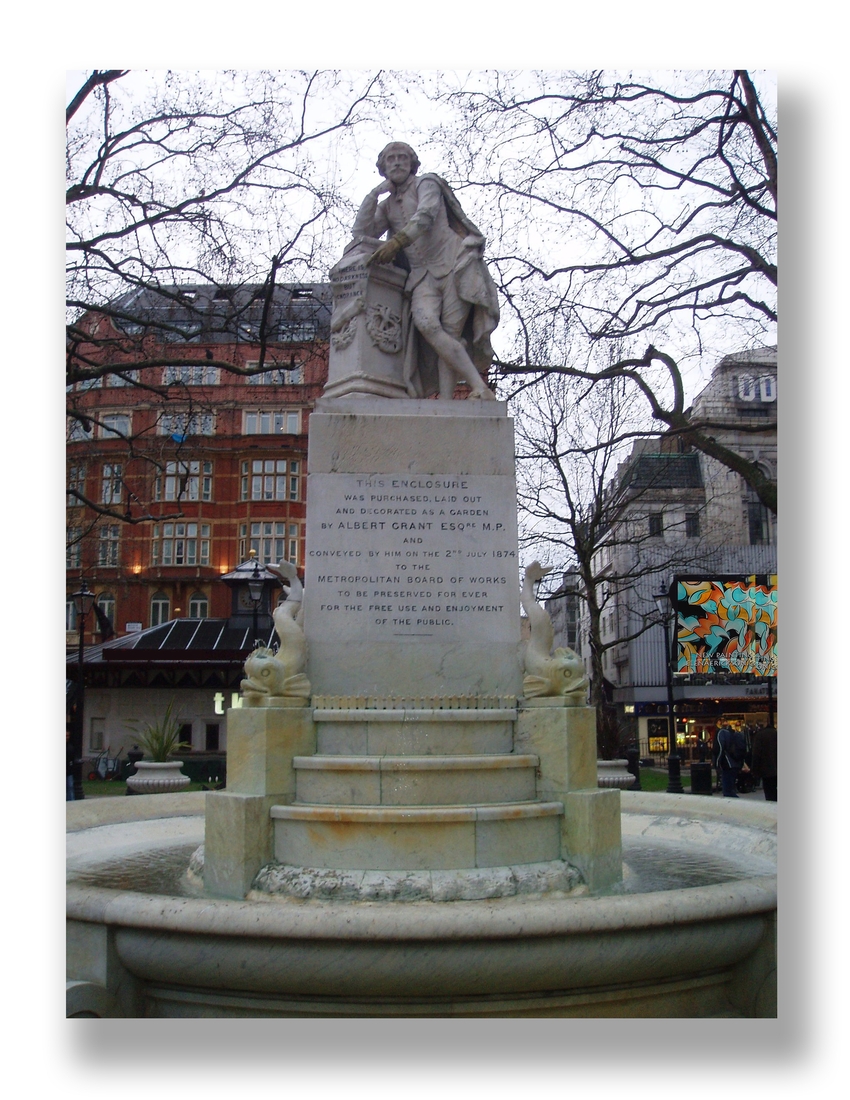|
Leicester Square in London, England
The Statue of William Shakespeare bears the inscription recording
the gift of Leicester Square to London by Albert Grant in 1874
This is a two Century ride along the family trail on how I am related to my Great
Great Grand Uncle Baron Albert Grant (Gottheimer). It begins with my mother
Bernice Lane (Hesslein) Erickson, from Brooklyn, New York. Though all this truly
originates with my mother's Grandmother Henrietta (Bach) Nathan, the first of my
mother's side of the family to be born in America.
Henrietta's parents were Wolff Bach (born in Baden, Germany/Prussia in 1820)
and Louisa Gottheime (born in London, England in 1829). Louisa's mother and
father are Elizabeth Zachariah and Lesser Gottheime. Now we are closing in on
the source of this journey, with Henrietta's Grandfather. Lesser Gottheime is the
younger brother of Berton Gottheime, which circularly brings us back down to
Berton's oldest child, his first son, Albert.
As this unique family tale goes, Baron Albert Grant was part scoundrel and part
brilliant scheming businessman in London, back in the mid-part of the 18th
Century. Albert was born in Dublin, Ireland in 1830 and the tale gets going some
twenty years later in London.
Some say his name was really Abraham. His father was German and mother English.
He was raised in both London and Paris. From 1859 to 1861 he was general manager of the Mercantile Discount Company. Around
this time he changed his name to Albert Grant and in 1863 he formed a firm which he named Albert Grant and Company. His practice
of business was dubious and he became quite wealthy. He would invest in failing unstable foreign companies and promote them
to the public at large boosting their perceived value. He became successful at this routine, regularly selling his shares in the company.
One of the local American promotions was worthless silver mines in Nevada.
In 1865 he was elected a Member of Parliament. He spent a tidy fortune on the election and served one term and did not seek re-election.
In 1874 he was again elected to Parliament, but later in the year was unseated due to election fraud and bribery charges.
In 1868 he was made a Baron by the King of Italy in thanks for construction projects he instituted in Milan.
He proudly referred to himself as Baron Grant for the rest of his life.
A contemporary of Albertís at the time is quoted as saying: ĒPersonally, Albert had at the magnetic temperament more highly developed than any man I ever knew.
His manners were engaging, he was simply a wonder at conversation, and as he spoke his handsome
face was lighted with candid smiles that no one could resist. Whoever came within the sphere of Baron
Grantís influence felt the intoxication of his powers to charm.Ē
In 1873 he started to build a mansion close to Kensington Palace which he named Kensington House. The mansion included a skating rink, an
ornamental lake and a bowling alley. It was viewed as a larger and far more decorative structure than Buckingham Palace.
Construction was completed in 1876. Bills for construction were never paid and the building was offered to the British government for sale. In the
end the building was never lived in by Albert Grant or his family and was sold a few years after completion. In 1882 it was demolished.
By 1874 Grant was getting considerable negative publicity due to his financial dealings, fraudulent schemes and dishonest business ventures.
To counter this and improve his reputation he purchased and restored the gardens of Leicester Square in London and eventually donated it to
the London Metropolitan Board. Leicester Square was named for Robert Sidney, the second Earl of Leicester, who originally purchased the four acres
of land in 1630. Sidney built a house and he enclosed the front area with a high metal fence and gate, which deprived the nearby neighbors and
passer-byes of using what had been for years common land.
The local folk appealed to King Charles I and eventually Lord Leicester was
ordered to keep part of the land open for use by all; this land later was called Leicester Square. In 1848 the courts reaffirmed, in the
case of Tulk vs. Maxhay, that the area could never be built upon. Lord Leicesterís house was eventually demolished and the area
became a dumping area for rubbish.
Albert Grant spent 30,000 Pounds buying Leicester Square and turned it into the area most are familiar with today.
Baron Albert Grant passed away in 1899, just weeks before the turn of the 19th Century.
"The Way We Live Now" is a satirical novel by Anthony Trollope, published in London in 1875. The lead character in the novel, Augustus Melmotte
is based on Albert Grant.
That is the story of Baron Albert Grant. Go to London and visit Leicester Square and view the statue of William Shakespeare high atop the square
bearing an inscription below recording the gift of Leicester Square by Albert Grant in 1874.
With assistance in the research / writing of this article by my cousins Eric Juda and Andy Weber is greatly appreciated.
| 